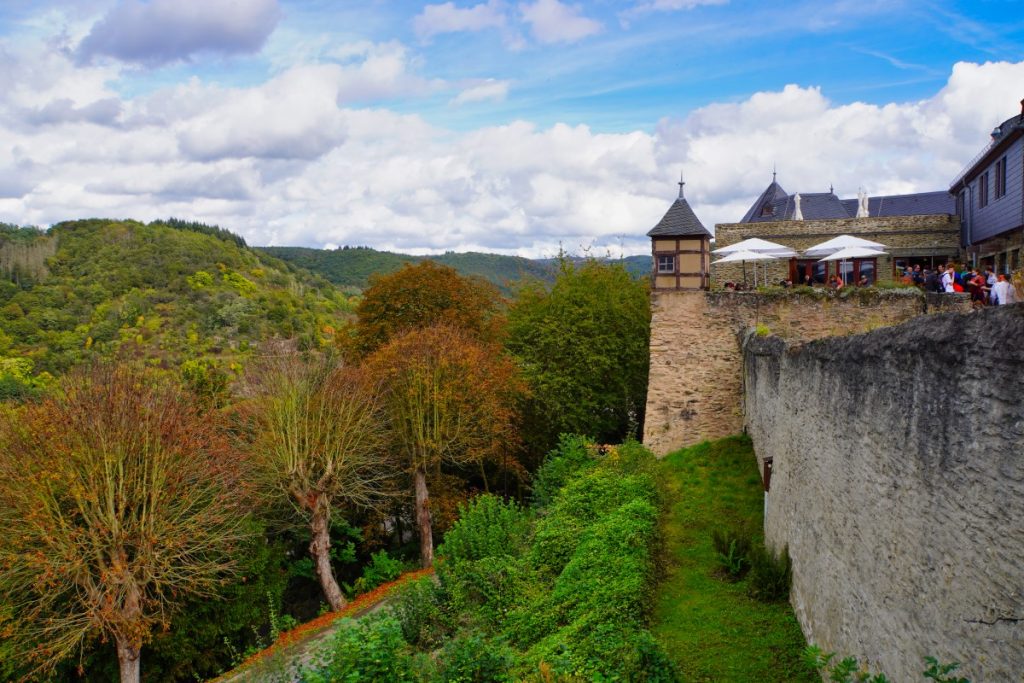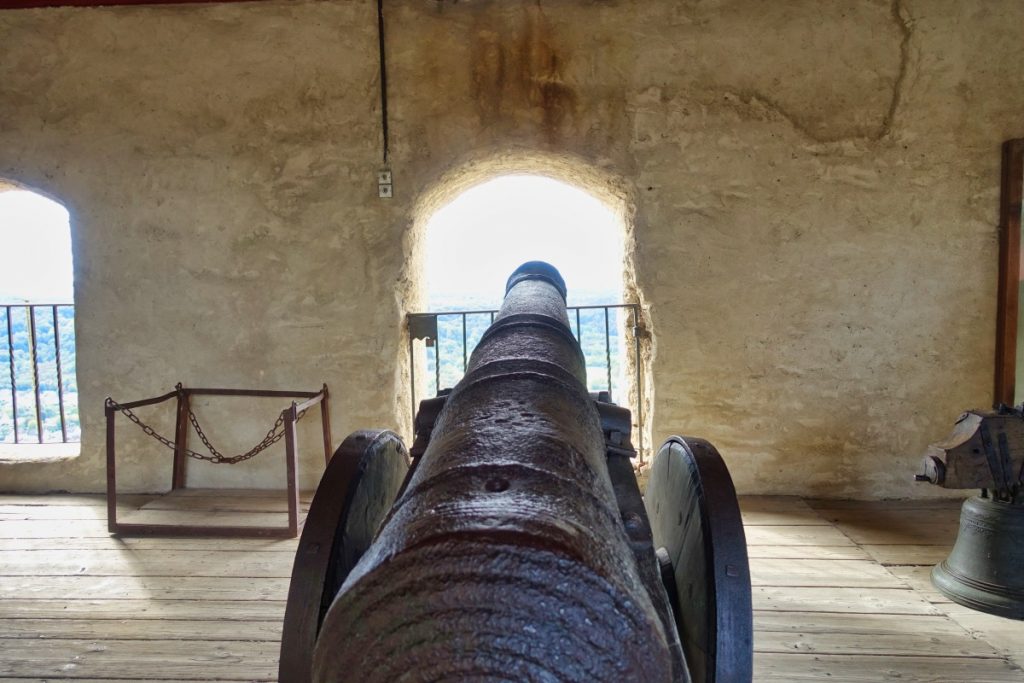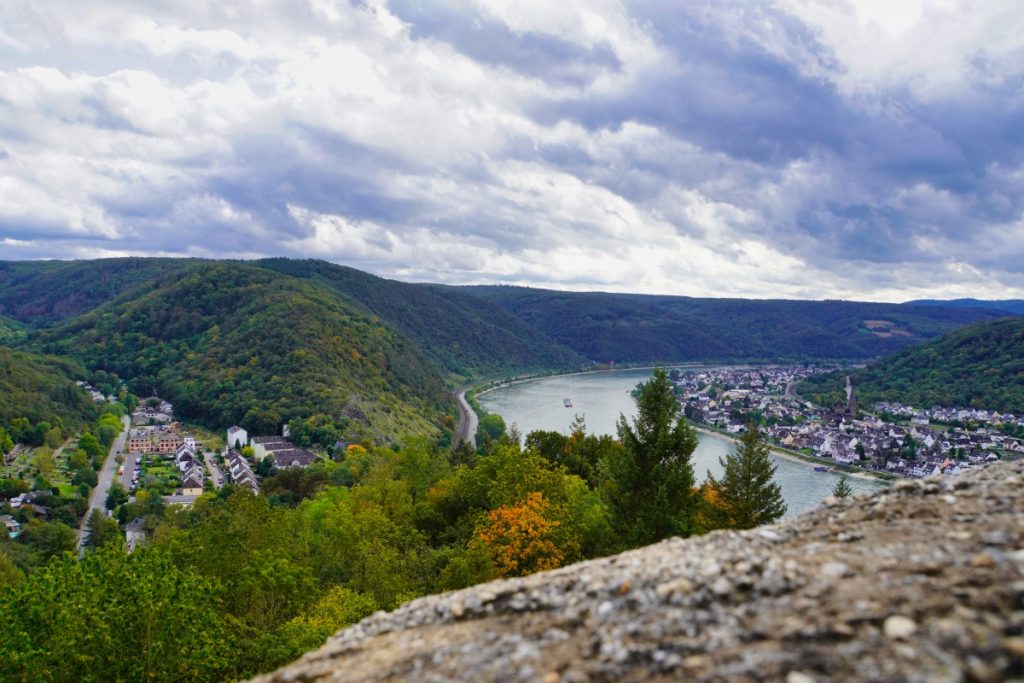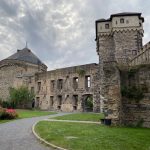On a 160 meter high slate cone, high above the small town of Braubach on the Romantic Rhine, stands the Marksburg. The hilltop castle from the 12th century is the only medieval castle on the Middle Rhine, which was never completely destroyed.
Countless castles once stood between Bingen and Koblenz. It is said that there was a castle about every 2.5 kilometers. Each of these castles secured the movement of goods in the region and each of the lords of the castles also demanded customs duties for them.
Many of these castles gradually fell into disrepair due to destruction (during the 30 Years War), by the troops of Louis XIV (the Palatine War of Succession of 1689), or simply due to abandonment. Then, in the 19th century, people started to rebuild the ruins.

Marksburg Castle is reportedly the only medieval castle on the Middle Rhine that has never been destroyed. One of the reasons is certainly the construction history of the castle.
View of the history of Marksburg Castle
The castle complex was built over a period of time from the early 13th century to the 18th century.
There are only a few traces left that point to the Romanesque foundation, However, according to investigations, it seems relatively certain that the origins of the keep lie in the 13th century. Traces dating back to around 1238 have been found that describe the tower as having a square cross-section and a wall width of more than 2 meters. Gerhard II of Epstein had it built at the highest point of the castle hill. He was also responsible for the construction of the Palas (today’s north building) and the Chapel Tower.

The core castle, which existed around 1300, was surrounded by a ring wall with a kennel. This area is today called the Inner Zwinger. The gate that was built at that time still exists today.

In the course of the next centuries, the lords of the castle continued to build diligently. Building areas were created for living and for representative purposes, the defense wall was strengthened and a battlement was added, the keep was raised ….. Of course, the builders also took into account the changing demands on the defense systems and adapted them to the latest weaponry.

After a fire in 1705, a half-timbered house was built on the foundation of the former bakehouse. This marked the end of building activity for a good 200 years. It was not until 1908 that the keep was restored.
Marksburg Castle did not survive the Second World War entirely unscathed. It took several years until the castle shone again in full beauty.
Castle tour – a guided tour lasting 50 minutes
The most beautiful view of the castle is certainly from the bank of the Rhine. We stopped before on a parking lot on the bank, which gave us a beautiful view of the Marksburg.
The castle can be visited only with a guided tour. There is nothing left of the original interior. Today, the interiors are furnished with gathered objects that fit into the concept of the museum tour and offer a great insight into castle life.

If you want to enter the castle complex, you first go through the drawbridge gate (from 1490) and a tunnel-like passage until you arrive behind the first wall.
The guided tour of Marksburg Castle then begins at the Fuchstor gate. The entrance gate is opened with a large key and closed again after the last participant. From there, the third gate building, and thus the third protective facility of the castle, is reached through the gateway kennel. From the gateway with its weir notch attacking enemies could be fought from above with arrows and stones. Having to cope with these three rather narrow entrances to the castle complex alone must have deterred possible attackers.
But before we made our way up, the pictures of the various coats of arms caught our eye. A coat of arms of each owner of the Marksburg has been hung here, starting in the 13th century with the Eppsteiners up to the German Castle Association, the current owner of the Marksburg.

Behind it, the path becomes somewhat uneven and you should pay close attention to where you step. In the Middle Ages, there was still a slope without steps that led to the outer area of the castle. Since horses could also walk along this path without any problems, this path is called equestrian steps. It was not until the 17th century that steps were cut into the rock. But I don’t think that these steps really make the way easier.
After climbing the horse stairs / incline, we were led on to the Great Battery. This gun emplacement faces the Rhine. The cannons on display there date from the Napoleonic era. Their range was enough to secure the entire width of the Rhine valley.

Around the castle there is a fortification. A small botanical garden has been created there, which displays many medieval useful and ornamental plants. In the small garden of magic and witch plants, you can find, for example, lovage, butterbur or henbane, depending on the season. But I’m much more interested in looking over the wall. Under the castle lies the Rhine and if I could have, I would have stayed here forever and enjoyed the beautiful view.




After the impressions around the buildings, the path then leads into some areas of the building. In a rather large hall-like room on the first floor with a huge fireplace, one has set up a medieval kitchen. Whether the kitchen was really located there, one does not know exactly. But that doesn’t matter, I find the design really successful. It illustrates very well with which means / equipment the kitchen staff worked at that time.


On the second floor, which we reach by a narrow and steep staircase, we enter the bower. The rooms that could be heated are called bower. Mostly they served as living and sheep rooms. The bed standing there looks very small. People in the Middle Ages were physically smaller than today, but it still looks a bit like a child’s bed.

After a wide large hall, which is furnished like a knight’s hall in Marksburg, we enter the small castle chapel. The chapel is located in the chapel tower and at first glance seems quite cramped. Only a few people could take part in a church service here. The walls are decorated with still well-preserved pictures and the late Gothic vault is very impressive.

Impressive are also the armory and the armory, which are shown during a tour of the Marksburg. In the rooms, which were once used by the castle command, there are numerous weapons that were discovered during restoration work. In the armory there are 14 figures dating back to 1880. The “Gimbel Collection” shows a compilation of various armors as they were worn by warriors from antiquity to the early modern period.
From there we take a look at the torture chamber. In the former stables of Marksburg Castle, for example, a rack and other torture devices are exhibited. Whether and where there was a torture chamber in the castle is not known. But since it belonged to a castle, it was decided to show the torture tools.

On the way to the exit we pass the castle smithy. This room is something special, because the walls are partly carved into the stone. The forge is fully equipped, from the anvil to the horseshoe nail you can discover a lot.

After a good 50 minutes, the tour ends at the door where it began. An interesting tour with a lot of information, during which I would have liked to have had more time at one or the other point to take in all the details or to be able to enjoy the view….

Address:
Marksburg
56338 Braubach
Directions:
Braubach is located on the right bank of the Rhine and can be reached via the B 42. Below the castle is a large parking lot for which a fee is charged. From there you can reach the entrance of the castle via 120 steps or a serpentine path.
Opening hours:
daily: 10-17 h
Guided tours:
daily from 11 h
Duration about 50 minutes
Admission fees:
Adults: 11,- €
Discounts are offered.
The visit to Marksburg Castle was a program item of the World Explorer Blogwärts Retreat and the Romantic Rhine Tourism GmbH.







Leave a Reply